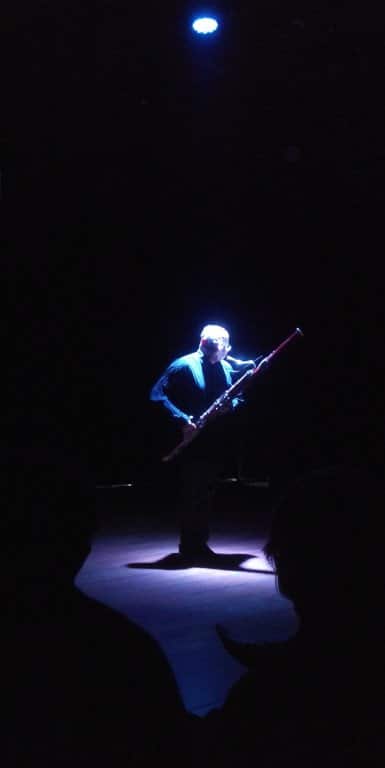Bassoonist Pascal Gallois gets laughs when he tries in vain to insert the flowers he has just received into the tube of his instrument. Also in the now classic Dialogue de l'ombre double by Pierre Boulez, he manages to make the audience chuckle on Sunday 19 June, when he produces a kind of elephant-like trumpet with much misfiring. His performance is part of the ''Save the bassoon', which will conclude on Sunday 25 June with a concert at the Holland Festival Proms at the Concertgebouw. For this hundreds of (amateur) bassoonists ON. Action successful, in other words.
The spot-on and enthusiastic performance by Pascal Gallois certainly won't hurt the image of this agile instrument either, even if by no means all the seats in the Bimhuis occupied. He opened with two miniatures by Hungarian composer György Kurtág, performed in a totally darkened hall. The bassoonist plays standing with his back to the audience, lit only by one bright blue spotlight. The theatrical approach fits wonderfully with the two hushed elegies for French poet Gérard de Nerval and Hungarian composer György Kroo.
Exciting listening adventure
Gallois makes the mainly descending lines flow smoothly, makes the multiphonics ('wrong lake sounds') into an exciting listening adventure and impresses with its tones swelling out of nowhere and dissolving back into nothingness. Thanks to circular breathing (you breathe in through your nose and simultaneously blow on the instrument with your mouth) he manages to perform the often very long lines without pauses for breath.
Also Torsion By Olga Neuwirth, focus composer of this edition of the Holland Festival requires a lot of circular breathing. Still Gallois stands in that blue column of light, but now turned sideways towards the audience. Neuwirth lets him explore every imaginable timbre, from deep rumbling bass and sputtering multiphonics to ultra-fast staccato loops bouncing through all registers, screeching outbursts and 'impossible' glissandi.
The argument is interspersed with recordings of street noise Neuwirth made in archtitect Daniel Libeskind's renowned 'voids' at the Jewish Museum in Berlin. Torsion concludes with a final cry of despair, recalling the calamity of the Jewish ram's horn.

The also specially composed Sequenza XII by Luciano Berio is just such an exploration of sound, with Gallois often having to play with 'false air' as well. Despite some virtuoso fireworks, Berio mainly emphasises the sonorous side of the bassoon with mostly long lines. Gallois plays without a lectern and faces the audience, still blue-lit. He bows deeply at the beginning and end, raising his instrument to heaven like an offering.
At Celluloid by Austrian composer Johannes Maria Staud, the bassoonist moves along five desks, this time bathed in a sea of red light. He prattles, snarls and snorts like a fiddle, but eventually ends on a kind of keynote.
Trumpeting elephant
Highlight of the evening is Dialogue de l'ombre double, which Pierre Boulez composed for Berio's 60th birthday. Originally for Alain Damien, the clarinettist of his own Ensemble Intercontemporain. At the request of Gallois, bassoonist of the same ensemble, he reworked it for his instrument. Speakers are set up around the audience, producing parts Gallois played in advance; he himself stands in a second circle of six desks on which the parts of the 20-minute piece are displayed.
Boulez shows his nimble side in this piece. Gallois plays short runs and shuttling figures, is 'surprised' by a reaction from one or more speakers and then continues imperturbably. Sometimes the speakers extend his tones with softly murmuring reverb, at other times they take complete control. Most exciting is the moment when lightning-fast motifs start circling around us like a man possessed and you almost get dizzy from the spinning movement of sound. Gallois resembles an elephant stamping and snorting to counterbalance the violence of technology, desperately trumpeting on its trunk.
Although all composers demand the utmost of his technique and stamina, Gallois does not miss a single note and seems tireless. His tone is warm and flawless, or dirty and disconcerting when the score demands it. He is the ideal defender of the bassoon and proves en passant that even with 'difficult' new music there is sometimes something to laugh about.
More info and tickets for final concert 'Save the bassoon' via this link.
